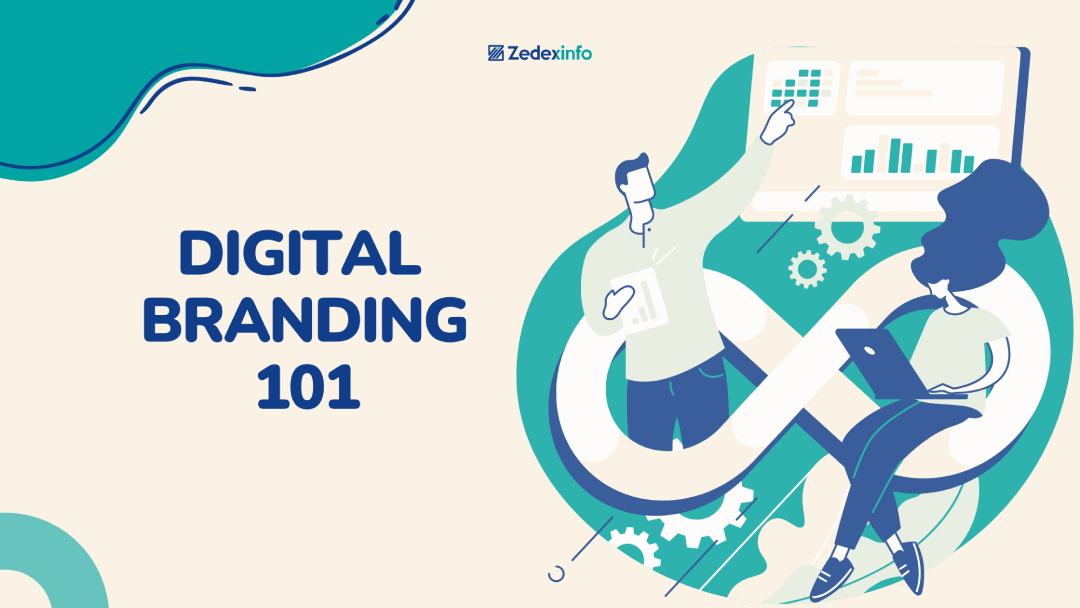Imagine walking into a store where everything feels right. The colors, the music, the theme, and the way the staff welcomes you all create a perfect experience. That’s branding. And when this experience happens online, it’s called digital branding. It is the art of making your business stand out and be remembered in the digital world.
However, many people confuse branding with just a fancy logo and a pretty website, which is not true. Digital branding is about creating a personality that sticks, a voice that speaks, and a presence that makes people connected. From social media and content to your website and design, every detail shapes your brand’s story. Strong digital branding has the power to build trust and turn casual visitors into loyal fans.
Whether you are an entrepreneur, a small business owner, or a marketing professional, understanding digital branding is essential for long-term success. In this blog, we will share a complete guide to digital branding to help you elevate your online presence.
What is Digital Branding?
Digital Branding is the process of creating a strong and recognizable online presence. It defines how people see, hear, and remember a brand, forming the foundation of its digital identity.
Digital branding mainly involves creating a brand’s identity, personality, voice, and visibility using digital tools and platforms. From logo and website to social media and marketing campaigns, every element works together to build an identity that stands out.
Businesses use websites, content marketing, email campaigns, social media, and digital ads to reach and engage with the target audience. The goal is simple: to make your brand memorable, earn trust, and boost conversions.
A strong digital brand helps you showcase your identity, authority, and credibility in a unique and impactful way. This builds trust and also shapes how people perceive and engage with your brand, developing meaningful connections.
Popular Example: Apple
Apple’s digital branding is a great example of consistency and impact. Their clean website, minimalist product design, and engaging marketing campaigns all reflect their brand identity beautifully.
Key Objectives of Digital Branding
Building Brand Awareness: The main objective of digital branding is to establish a strong online presence that makes your brand easily recognizable.
Establishing Credibility and Trust: Building a trustworthy image through customer reviews, storytelling, and transparent communication.
Audience Engagement: Encouraging interaction and building meaningful connections with the target audience through interactive and personalized content.
Driving Conversions and Sales: Attracting potential customers and influencing purchasing decisions by marketing offerings and guiding them through a digital funnel.
Ensuring Consistency: Maintaining a uniform brand image across all online channels using the same messaging, theme, voice and tone.
Fostering Customer Loyalty & Retention: Strengthening relationships with existing customers through loyalty programs, email marketing, and exclusive offers.
How to Create a Successful Digital Branding Strategy?
Digital branding strategy is more than just visuals. It involves key components that work together to shape how your brand is seen and perceived in the digital space. Have a look at each component in detail and how to use them effectively.
Brand Identity and Consistency
The first and most important component of strong digital branding is a clear brand identity. It’s basically how you present your business in the digital world. Brand identity involves visual as well as non-visual elements that represent your brand’s personality, values, and overall image. It’s essential to maintain a consistent brand identity to differentiate your brand from others and ensure customers recognize it. It mainly includes:
Logo and Visual Elements: The logo and visual elements give your brand its distinct identity, making it easy to recognize and remember. A consistent color palette, design style, and typography are crucial to maintaining a strong and cohesive brand identity.
Brand Voice and Tone: A brand’s voice and tone determine how it engages with customers, reflects its personality, and sets the overall style of its messaging. Whether casual, formal, friendly, or authoritative, ensure a consistent voice and tone across all platforms.
Brand Messaging: Brand messaging focuses on what your brand communicates. It includes key messages, values, benefits, and promises that define your brand’s identity. Use a clear, relatable, and strong brand message that aligns with your brand’s mission and values and resonates with your audience.
Unique Value Proposition: To stand out from the crowd and develop a loyal community, make sure to share the Unique Value proposition of your brand. It basically tells customers what makes your brand different and why they should choose you over others.
Website & Positive User Experience
A website serves as your brand’s online storefront. It is the place where your customer actually gets to know about your brand, offerings, and services and thus interacts with your business. A well-designed and easy-to-navigate website improves user experience, encouraging visitors to interact with your brand effortlessly. Key elements include:
User-Friendly Design: Your website should be user-friendly, meaning it must be responsive, fast-loading, easy to navigate, and mobile-optimized. It should load quickly and have a clear, intuitive interface to ensure a positive user experience.
Search Engine Optimization: SEO is one of the most crucial aspects of a website. It optimizes your content for both users and search engines. The better the optimization, the higher your website ranks and the more visible it becomes online.
Content Strategy: A strong content strategy is the foundation of effective digital branding. Make sure to include engaging blogs, visual content, customer testimonials, case studies, and interactive content to hook the audience.
Active Social Media Presence
Social media is a valuable tool for brand engagement and visibility. To reach your target audience, a strong and active social media presence is crucial. The best option is to choose 2-3 platforms where most of your target audience is present and leverage them to promote your business. Effective strategies include:
Platform Consistency: The logo, typography, colors, and brand voice define the identity of your brand. Therefore, it’s important to use the same brand elements across all social media platforms, such as Instagram, Facebook, LinkedIn, and Twitter.
Engaging Content: Social media platforms have high competition, so it’s crucial to keep your audience interested by sharing engaging content. Create a strong content strategy, including regular posts, UGC content, interactive stories, behind-the-scenes content, trending challenges, etc.
Customer Interaction: Engage with your audience on social media to make them feel valued. Interact with followers, respond to comments and DMs, host live sessions, use interactive story features, hold Q&A sessions, etc., to connect with your audience personally.
Effective Growth Strategies: Posting high-quality content isn’t enough in a highly competitive social media world. Effective strategies like high-quality visuals, relevant hashtags, trending audio, optimal posting times, strategic keywords, and engaging captions are essential for maximizing reach and engagement.
Digital Advertising & Outreach
Besides website and social media, digital advertising and outreach are also important to ensure wider reach and visibility. Advertising allows you to reach your target audience and promote your offerings in an easy and time-saving manner. If you have a high marketing budget, advertising is a goldmine to skyrocket leads and conversions. Key strategies include:
Search Engine Ads: Search engine ads appear at the top of the search engine result page. When users enter a keyword you target, your ad appears before the organic results, increasing your chances of getting a customer. Make sure to set a reasonable budget, pick the right keywords, and write engaging ad copy.
Display Ads: These are clickable banners that appear on various websites in different shapes and dimensions. Creating an engaging, attractive, and valuable display ad can attract a large number of visitors who may convert into loyal customers.
Social Media Ads: Facebook, Instagram, Twitter, and LinkedIn all platforms offer ads to target a specific segment and boost engagement and conversions. Make sure to create visually appealing and impactful social media ads to fulfill your purpose.
Influencer Marketing: It involves partnering with influencers or content creators to expand the reach and credibility of your business. Collaborating with micro-influencers is a great way to connect with a loyal, targeted audience and increase engagement and sales.
Content Marketing & Storytelling
At present, advertising your offerings is not easy. It requires informative, visually appealing, and engaging content to capture audience interest and build trust. Content is at the heart of digital branding. It is like the human side of your brand that informs, connects, and adds value to your audience. A strong content marketing strategy includes:
Blogging: Today, the majority of the audience uses the Internet to get information. In such a situation, blogging is the most important aspect of content marketing. Create and post educational, informative, and relevant posts that resonate with your target audience. The blogs should attract, inform, and hook your audience.
Visual Content: Text-based content is important, but visual content grabs attention faster and leaves a stronger impact. Use eye-catching images, videos, and graphics like testimonials, explainer videos, infographics, etc., to make your brand more engaging and memorable.
Storytelling: Everyone posts direct content, but what can make you different from others is how you present your content. Storytelling is an important aspect of content marketing. Connect with your audience on a deeper level by sharing your brand’s journey, mission, goals, struggles, milestones, and impact.
Email Marketing & Community Building
Although some marketers now believe that email marketing is dead, top CEOs claim that it is still a powerful tool for customer engagement and conversions. It is indeed one of the most important components of digital branding, helping you build relationships, nurture leads, and drive sales. Here’s how to use both of them:
Email Marketing: Personalized campaigns can help you nurture leads and convert them into customers. Offer lead magnets like e-books, discounts, templates, or exclusive content. You can also run giveaways and referral programs to encourage signups. Just make sure to segment your audience properly and use personalized subject lines to increase open rates.
Community Building: Create a space where your audience feels connected and valued like Facebook Group, Discord, or private forum. Offer exclusive content, memberships and interact directly to boost leads and conversions. Encourage active participation through discussions, user-generated posts, Q&A sessions, challenges, etc.
Online Reputation Management
Online reputation management is key to earning customer trust and loyalty. It strengthens your relationship with your audience, turning them into loyal customers or followers. The more trustworthy and genuine your brand appears, the higher the chances of driving sales and conversions. Strategies to ensure a positive brand reputation include:
Transparency: It’s important to be honest about your products, services, benefits and values to build trust and loyalty. Avoid exaggerating claims you can’t deliver, as authenticity fosters long-term customer relationships.
Social Proof: Social proof is extremely important to showcase to customers that real people use and love your products and services. Include customer reviews, testimonials, and case studies of satisfied customers to show credibility and build trust.
Authentic Engagement: Interact genuinely with your audience through meaningful conversations and responses. Understand their problems, address their concerns, and provide solutions in a helpful way. Provide exceptional customer service to keep your customers happy and satisfied.
Partnerships: Collaborating with reputable brands or influencers can present you as a credible and authoritative figure in the market, enhancing your online reputation. When influencers promote your brand, customers are more likely to trust and engage with it.
Analytics & Performance Tracking
Analytics & Performance Tracking is essential for understanding what’s working and what needs improvement in your digital branding strategy. It helps you avoid common pitfalls and refine your strategy according to the performance and customer interests. Here’s how to effectively monitor and optimize performance across key channels.
Website Analytics: Monitoring website traffic and user behavior is important to understand your traffic sources, bounce rate, average session duration, and conversion rate. This helps you find high performing and underperforming pages so that you can improve low performing ones.
Social Media Analytics: Track your social media growth with Instagram Insights, Facebook Business Suite, Twitter/X Analytics, and LinkedIn Analytics. Check follower growth, engagement rate, reach, impressions, CTR, and best-performing content. Refine your strategy accordingly and see improvements.
SEO and Content Performance: Analyzing SEO and content performance is extremely important to check your organic growth. Use tools such as Google Search Console, Ahrefs, SEMrush, and Ubersuggest to track keyword ranking, backlinks, organic traffic, and time spent.
A/B Testing: Experiment with different content strategies to see what works best for your brand. By testing variations of your content, posting times, keywords, hashtags, and other engagement tactics, you can refine your approach for better reach and conversions.
Conclusion
Digital branding is creating and maintaining a strong digital presence to reach customers, boost engagement, and drive sales and conversions. To ensure proper digital branding, utilizing the key components effectively and efficiently is important. Maintain a robust and consistent brand presence across all platforms, from search engines to social media. An active and user-friendly website, strong social media presence, and effective content marketing are extremely important. Besides that, you should also invest in digital advertising, email marketing, and online reputation management to stand out and shine more.



